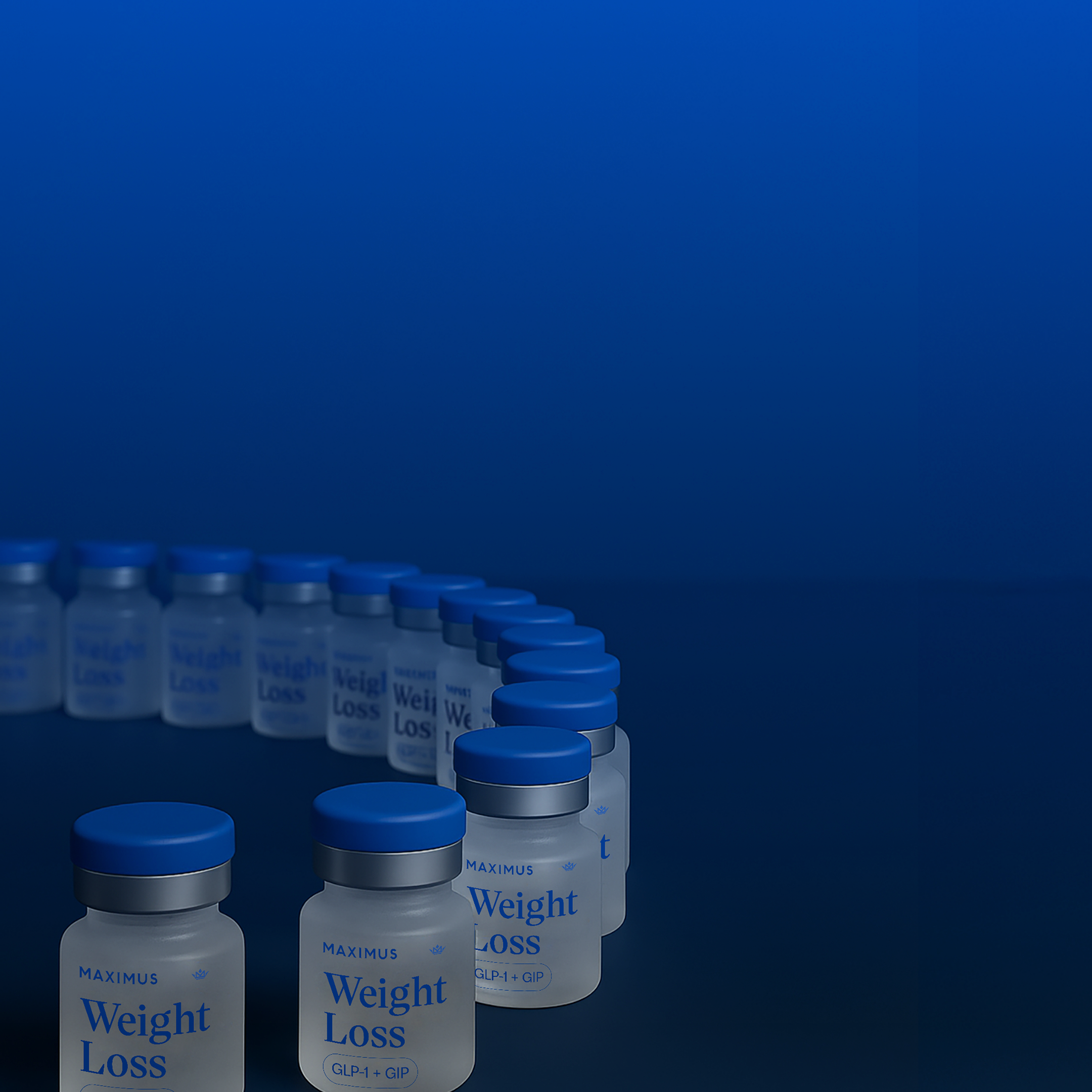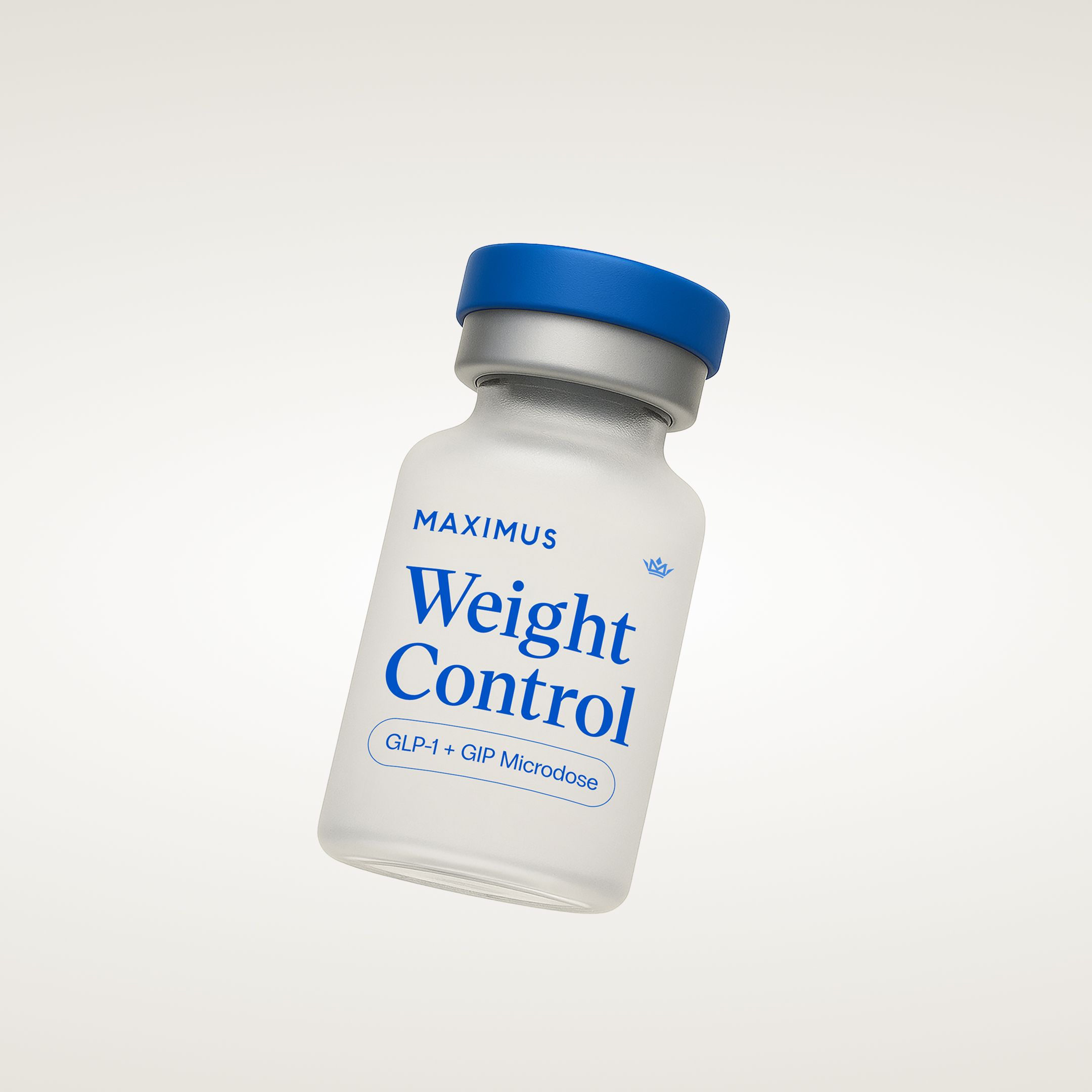Updated 11/05/2025
By Starling Krentz, MS and Gabriel Alizaidy, MD, MSThe concept of microdosing sounds counterintuitive at first. Take less of a drug and still get the benefits? But that's exactly what's happening with GLP-1s, and the data backs it up.
Semaglutide and tirzepatide have taken over headlines for their dramatic weight loss results at full doses, but a growing body of research shows that microdoses can deliver meaningful metabolic improvements with far fewer side effects. At Maximus, we now offer microdosing protocols for both medications, giving patients more control over their treatment intensity.
What are GLP-1s (and GIP)?
GLP-1 is a gut hormone released after eating. It slows gastric emptying, helps your pancreas release insulin, and regulates blood sugar. GLP-1 medications amplify these natural effects, and because GLP-1 receptors exist in the pancreas, liver, brain, heart, and kidneys, the benefits extend far beyond just metabolic control.
Tirzepatide works differently because it activates both GLP-1 and GIP receptors. GIP (glucose-dependent insulinotropic polypeptide) is another gut hormone that your body naturally uses as its primary hunger suppressant. Recent research shows that GIP directly regulates the brain's hunger neurons after you eat.
While pharmaceutical doses of GLP-1 can force appetite suppression (which is why semaglutide often causes nausea), GIP activates the pathway these neurons are designed for. The dual action makes tirzepatide particularly effective at reducing appetite without relying entirely on GLP-1's side effects, while also improving lipid profiles and metabolic markers.
How Microdosing Works
Microdosing means using a fraction of the standard dose. The goal is to find the lowest effective dose and maintain it.
GLP-1 medications have long half-lives and bind strongly to proteins in your blood, which means even small amounts can sustain receptor activation over time. Steady plasma concentrations are reached within 4-5 weeks, even at these lower doses. You don't need high concentrations to engage enough receptors for clinical effects.
Who Microdosing Works For
Microdosing works well for people who are mildly overweight, in early stages of metabolic dysfunction, or trying to stay ahead of bigger problems. It's also a strong option for people taking a proactive approach to their health rather than waiting for problems to develop. Someone showing signs of metabolic syndrome like elevated triglycerides, increased waist circumference, high blood pressure, or insulin resistance might not need aggressive dosing. They might do perfectly fine on a fraction of the standard dosing schedules for years, keeping their metabolic markers in check without aggressive intervention.
More advanced cases of obesity or diabetes may need higher doses, though even those patients might benefit from starting low and escalating only if needed. If you want to add one thing to supplement your lifestyle that gives you the most bang for your buck (outside of hormone therapy), microdosing GLP-1s offers a powerful option that you can maintain long term without the typical side effects or costs.
The Core Benefits of Microdosing
Liver and Cardiovascular Protection
A 72-week trial found 40% of patients achieved resolution of fatty liver disease without worsening fibrosis.¹ In animal models, GLP-1s suppress fat production in the liver and reduce inflammation.²
Tirzepatide at low doses showed particularly strong cardiovascular benefits, with meaningful improvements across multiple lipid markers linked to heart disease risk.³ Cholesterol storage forms increased far less with tirzepatide, and harmful lipids like ceramides showed minimal increase compared to placebo.
Large trials show fewer heart attacks and strokes with GLP-1 use through improved endothelial function, reduced oxidative stress, and better nitric oxide availability.⁴ ⁵ If other benefits manifest at lower doses, cardiovascular protection likely does too.
Blood Sugar and Metabolic Benefits
For tirzepatide at low doses, glucose control improved significantly across fasting and post-meal measurements.³ Markers of pancreatic function showed substantial improvement, suggesting GLP-1s protect the cells that produce insulin.⁶ This could explain why metabolic benefits last beyond treatment.
Kidney Protection and Brain Health
A trial found semaglutide reduced kidney events by 24% in people with type 2 diabetes and chronic kidney disease using a lower dose, not the maximum.⁷ GLP-1s also strengthen the blood-brain barrier and enhance neuron survival, with early data hinting at benefits for cognitive decline and Alzheimer's disease.⁸ ⁹ ¹⁰
Systemic Anti-Inflammatory Effects
GLP-1s reduce systemic inflammation throughout the body.¹¹ This benefit doesn't get talked about much, though inflammation drives almost every chronic disease.
Why Lower Doses Work
GLP-1s have long half-lives and potent receptor activity, which explains why even low plasma concentrations trigger meaningful clinical effects. Full activation isn't necessary because modest receptor signaling can still drive important metabolic and cardiovascular benefits. In clinical studies, the highest doses get the spotlight, though lower doses deliver significant results too. Perhaps more isn't always better when you look at how these receptors work.
Microdoses. Major Impact.
The minimum effective dose has been a cornerstone of medicine for decades. Microdosing GLP-1s brings that principle back into focus. Small doses trigger real improvements in metabolism, liver health, cardiovascular function, and inflammation without overwhelming your system. Minimal interventions, when done right, can lead to maximal outcomes.
At Maximus, we now offer microdosing for tirzepatide on top of our previous offering of semaglutide, giving you the option to start low and find the dose that works for your goals without unnecessary side effects or costs.
----
Disclaimer: The contents of this article, including, but not limited to, text, graphics, images, and other information, is for information purposes only and does not constitute medical advice. The information contained herein is not a substitute for and should never be relied upon for professional medical advice. The content is not meant to be complete or exhaustive or to be applicable to any specific individual's medical condition. You should consult a licensed healthcare professional before starting any health protocol and seek the advice of your physician or other medical professional if you have questions or concerns about a medical condition. Always talk to your doctor about the risks and benefits of any treatment. Never disregard or delay seeking professional medical advice or treatment because of something you have read on this site. Maximus does not recommend, endorse, or make any representation about the efficacy, appropriateness, or suitability of any specific test, products, procedures, treatments, services, opinions, healthcare providers or other information contained herein. Maximus is not responsible for, nor will they bear any liability for, the content provided herein or any actions or outcomes resulting from or related to its use.
----





